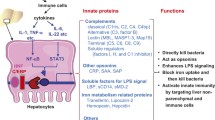Abstract
Biglycan, a small leucine-rich proteoglycan (SLRP), is a crucial component of the extracellular matrix (ECM) associated with the maintenance of tissue homeostasis. In response to tissue damage, the ECM-derived soluble form of biglycan acts as a danger signal by triggering an inflammatory response via the toll-like receptor (TLR)2/TLR4 in macrophages and dendritic cells. The impact and signaling mechanism of biglycan in innate immunity is better understood with the use of specific and reliable research tools and investigation techniques. Accordingly, our lab has established explicit and detailed experimental protocols to examine the in vitro and in vivo effects of biglycan in cellular immune responses. To evaluate the in vitro effects of biglycan on macrophage activation, a comprehensive protocol that makes use of murine peritoneal macrophages has been described. Further, to study the in vivo effects of biglycan, a method that uses a pLIVE vector to generate transgenic mice transiently overexpressing human biglycan is detailed. A step-by-step protocol for analyzing the effects of soluble biglycan overexpression in transgenic mice is explained under the following sections: (1) construction of pLIVE-hBGN plasmid, (2) intravenous delivery of transgenic vector, (3) identification of hBGN transgene in hepatocytes (4) detection of transgenic biglycan protein in the plasma of transgenic mice, and (5) evaluation of the presence and pro-inflammatory effects of transgenic biglycan in extrahepatic mouse tissues.
Access this chapter
Tax calculation will be finalised at checkout
Purchases are for personal use only
Similar content being viewed by others
References
Bianco P, Fisher LW, Young MF, Termine JD, Robey PG (1990) Expression and localization of the two small proteoglycans biglycan and decorin in developing human skeletal and non-skeletal tissues. J Histochem Cytochem 38(11):1549–1563
Nastase MV, Young MF, Schaefer L (2012) Biglycan: a multivalent proteoglycan providing structure and signals. J Histochem Cytochem 60(12):963–975
Schaefer L, Babelova A, Kiss E, Hausser HJ, Baliova M, Krzyzankova M, Marsche G, Young MF, Mihalik D, Gotte M, Malle E, Schaefer RM, Grone HJ (2005) The matrix component biglycan is proinflammatory and signals through toll-like receptors 4 and 2 in macrophages. J Clin Invest 115(8):2223–2233
Babelova A, Moreth K, Tsalastra-Greul W, Zeng-Brouwers J, Eickelberg O, Young MF, Bruckner P, Pfeilschifter J, Schaefer RM, Grone HJ, Schaefer L (2009) Biglycan, a danger signal that activates the NLRP3 inflammasome via toll-like and P2X receptors. J Biol Chem 284(36):24035–24048
Zeng-Brouwers J, Beckmann J, Nastase MV, Iozzo RV, Schaefer L (2014) De novo expression of circulating biglycan evokes an innate inflammatory tissue response via MyD88/TRIF pathways. Matrix Biol 35:132–142
Roedig H, Damiescu R, Zeng-Brouwers J, Kutija I, Trebicka J, Wygrecka M, Schaefer L (2020) Danger matrix molecules orchestrate CD14/CD44 signaling in cancer development. Semin Cancer Biol 62:31–47
Moreth K, Brodbeck R, Babelova A, Gretz N, Spieker T, Zeng-Brouwers J, Pfeilschifter J, Young MF, Schaefer RM, Schaefer L (2010) The proteoglycan biglycan regulates expression of the B cell chemoattractant CXCL13 and aggravates murine lupus nephritis. J Clin Invest 120(12):4251–4272
Wynn TA, Chawla A, Pollard JW (2013) Macrophage biology in development, homeostasis and disease. Nature 496(7446):445–455
Zhang X, Goncalves R, Mosser DM (2008) The isolation and characterization of murine macrophages. Curr Protoc Immunol Chapter 14:14.1
Ray A, Dittel BN (2010) Isolation of mouse peritoneal cavity cells. J Vis Exp 35
Leijh PC, van Zwet TL, ter Kuile MN, van Furth R (1984) Effect of thioglycolate on phagocytic and microbicidal activities of peritoneal macrophages. Infect Immun 46(2):448–452
Kumar TR, Larson M, Wang H, McDermott J, Bronshteyn I (2009) Transgenic mouse technology: principles and methods. Methods Mol Biol 590:335–362
Snyder LL, Esser JM, Pachuk CJ, Steel LF (2008) Vector design for liver-specific expression of multiple interfering RNAs that target hepatitis B virus transcripts. Antivir Res 80(1):36–44
Monfort J, Tardif G, Reboul P, Mineau F, Roughley P, Pelletier JP, Martel-Pelletier J (2006) Degradation of small leucine-rich repeat proteoglycans by matrix metalloprotease-13: identification of a new biglycan cleavage site. Arthritis Res Ther 8(1):R26
Acknowledgments
This work was supported by the German Research Council (SFB 1039, project B02, SFB 1177, 259130777, project E02 (both to LS)); the Cardio-Pulmonary Institute ((CPI), EXC 2026, Project ID: 390649896 (to LS and MW)); the Hessian Ministry within the LOEWE Research Initiative ACLF-I (To LS and JT); European Union’s Horizon 2020 Research And Innovation Program’s MICROB-PREDICT study (No 825694); European Union’s Horizon 2020 Research and Innovation Program’s GALAXY (No. 668031) and Societal Challenges LIVERHOPE (health, demographic change, and well-being, No. 731875); the German Research Council (SFB TRR57, CRC1382); and Cellex Foundation (PREDICT) all to JT.
Author information
Authors and Affiliations
Corresponding author
Editor information
Editors and Affiliations
Rights and permissions
Copyright information
© 2023 The Author(s), under exclusive license to Springer Science+Business Media, LLC, part of Springer Nature
About this protocol
Cite this protocol
Zeng-Brouwers, J., Huber, L.S., Merline, R., Trebicka, J., Wygrecka, M., Schaefer, L. (2023). Evaluation of the In Vitro and In Vivo Effects of Biglycan in Innate Immunity. In: Karamanos, N.K. (eds) Proteoglycans. Methods in Molecular Biology, vol 2619. Humana, New York, NY. https://doi.org/10.1007/978-1-0716-2946-8_9
Download citation
DOI: https://doi.org/10.1007/978-1-0716-2946-8_9
Published:
Publisher Name: Humana, New York, NY
Print ISBN: 978-1-0716-2945-1
Online ISBN: 978-1-0716-2946-8
eBook Packages: Springer Protocols




